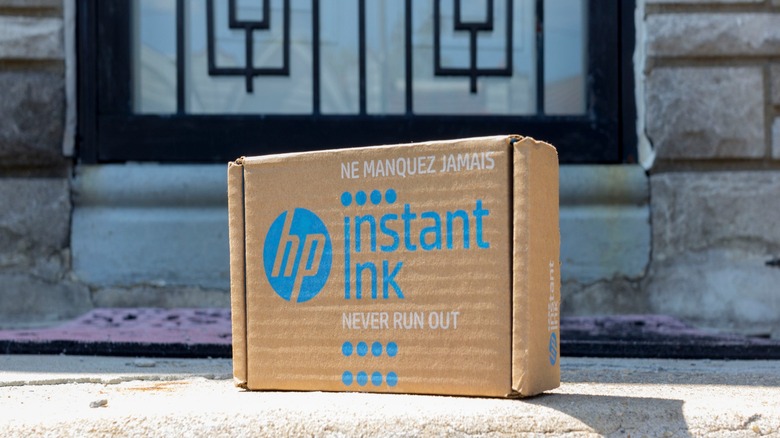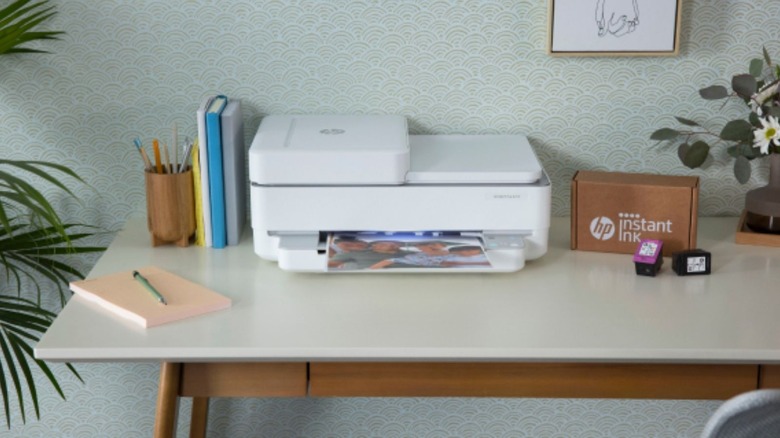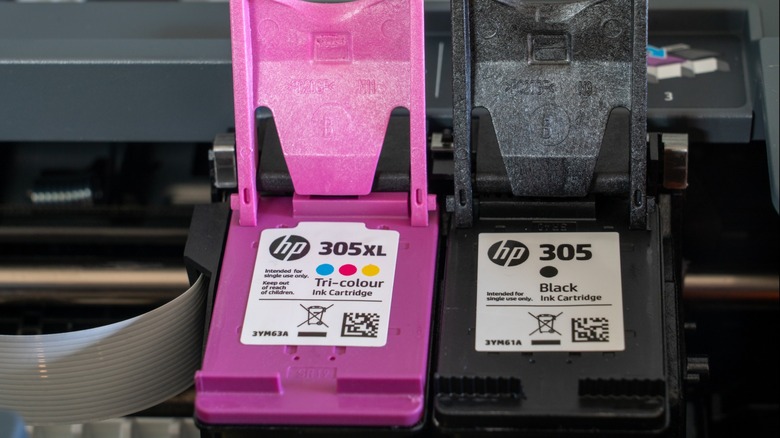HP Instant Ink: How The Controversial Subscription Works And Why It Has Users Up In Arms
There was once a time when you could print as much as your at-home ink and paper supply allowed. Then, when the ink ran out, you ran to Best Buy, Walmart, or Office Depot for a new cartridge. Eventually, the increasingly popular subscription model started to creep itself into home printers, leaving consumers to decide whether the old or new way of life benefited them most.
In a March 2024 announcement, HP revealed its "All-in" plan, a monthly subscription that includes a printer but limits the number of monthly prints. For example, for $35.99 per month, you can get a new HP OfficeJet Pro with up to 700 prints. While HP can try to justify the benefit of a subscription model, not everyone will see the value. Even the considerably cheaper HP Instant Ink plan puts stringent limitations on how many pages you can print per month, with the lowest tier costing $1.49 for 10 prints per month and the highest running $27.99 for no more than 700 prints. While being able to customize your printing costs sounds like a convenience for you and your wallet, it takes digging deeper into the nitty gritty of HP Instant Ink plans to determine if they're worthwhile for all or better suited for a specific audience. After all, there must be a reason why some users are calling it a scam, and others are more willing to back HP and its ink delivery service.
How do the Instant Ink and All-in plans work?
The basis for both the All-In and Instant Ink plans actually has nothing to do with your ink usage. It's all about print output. All-In simply adds the cost of leasing a printer. For both plans, you'll need to estimate how many pages you print each month and choose between five tiers: 10, 50, 100, 300, or 700 pages. Depending on the plan, if you go over one month, HP charges at least an additional $1.00 for every 10 to 20 pages. Should you come in under your allotted amount, they will roll over up to two to three times that plan's allowance. The catch is that even if you come in short, say printing only 250 pages on the 700-page plan, you're still charged the full $27.99. This is where Instant Ink can become yet another nuisance subscription.
HP leaves it up to the user to ensure they have the best plan for their printing needs every month. This means paying close attention to month-to-month output. If your printing isn't consistent, you could be on a higher tier than needed and paying much more than you should be. Another thing to remember is that the ink cartridges shipped as part of the Instant Ink program are tied to the subscription model. If you cancel your plan mid-month or have ink left over when you don't renew, that cartridge will be deactivated, and you'll have to purchase one retail.
Will HP's ink plans save you money?
According to HP, subscribing to Instant Ink can save you approximately 50% on printing costs. Looking at the HP 67XL High Yield black cartridge, we can estimate just how accurate that is. Per the HP 67XL High Yield Black cartridge listing, each cartridge yields about 240 pages. If you're printing the equivalent of the Light plan (10 pages per month for $1.49), that high-yield cartridge should last you about two years (240-page yield divided by 10 pages per month equals 24 months of ink). At that rate, you'd have spent $35.76 ($1.49 multiplied by 24 months) on the Instant Ink plan compared to $28.99 for one ink cartridge. The value does flip, though, when you move up to the Occasional plan, which provides 50 prints per month for $4.99. At 50 pages, the cartridge would last just under 5 months, meaning you'll go through 2.5 cartridges in a year. That cost comes to $72.47 compared to the plan's $59.88 yearly cost.
The thing to keep in mind is that the 240-page estimate for the 67XL High Yield cartridge doesn't factor in pages that may have minimal ink on them, while those very same pages will be counted as a full page by the Instant Ink plan. Thankfully, if your printer spits out blanks, those are not counted. So, if your cartridge lasts even 300 pages, the individual cartridge winds up being cheaper. Ultimately, savings only exist on higher-tier subscriptions.
Why are users unhappy with the Instant Ink model?
One of the biggest issues with HP's Instant Ink subscription model is that many users don't quite understand what they're buying into. Many posts on Reddit highlight having never been sent a cartridge over the length of their subscription. User u/PickleDragons, who had their plan for "almost a year," notes, "[HP] sent me ink once and haven't again since even though I've contacted and complained."
The same complaints have been waged in posts as old as 2018, which suggests that users believe they're paying for monthly (or at least occasional) ink shipments rather than a page count and the convenience of not having to purchase ink separately. While HP does monitor ink levels via the printer's Wi-Fi connection and ships new cartridges as needed, the base metric for the monthly cost continues to be page count.
Another common complaint is the fact that Instant Ink cartridges are locked when a subscription is canceled, despite how much ink they may have remaining. Reddit user u/JillYael007 highlights what may be the crux of what the subscription service feels like: "HP makes you pay monthly to use your own printer..."



